1st Battalion, 26th Infantry Regiment (1st Infantry Division)
13 - 22 September 1944
At 1500 on 17 September 3rd Armored Division - ostensibly unaware of the arrival of 12 ID and its intention to re-occupy the Westwall between Stolberg and Zweifall — but alarmed by the vigorous counterattack CCB encountered at Weissenberg, ordered TF Hogan to send a rifle company to CCB at Diepenlinchen, 4000 meters to the northeast of Busbach, some 600 meters northwest of Mausbach. Company C (Captain Allan B. Ferry commanding) mounted on trucks, and reported as ordered to Diepenlinchen about 1900.
Captain Ferry was briefed by Colonel John C. Welborn of CCB (commander of the 33d Armored Regiment) that Weissenberg and Hill 283 north of Diepenlinchen, harbored a cluster of infantry-defended antitank guns that was holding up the advance of its armor. Task Force Lovelady of CCB had attacked to seize the enemy strongpoint, but had been driven off by a determined enemy counterattack. Elements of the 36th Armored Infantry Regiment were believed to be still holding out on the hill. Capt. Ferry's mission was to attack through Diepenlinchen to envelop Weissenberg from the east, and to take the enemy positions there. Secondarily, he was to re-establish contact with cut-off 36th Armored Infantry elements, evacuate their wounded, and recover U.S. weapons abandoned on position. It was by then dark and foggy. Ferry had no time for more than a cursory map reconnaissance.
Diepenlinchen and Weissenberg were part of an industrial complex that included, besides the usual dwellings and gardens, a number of deep, steep-sided excavations, and a jumble of piled rock and sand. There were also factory buildings, some of substantial brick construction.

At 2000 Company C started forward with a platoon of tanks attached, seeking to skirt the east side of Diepenlinchen. There was a brick wall on one side of the road, and one of the tanks accidentally crushed an infantryman against the wall. Immediate calls for medics apparently triggered a German ambush. There was a storm of deadly fire, in which the 2d Platoon, in the lead, was cut off from the company, and the platoon leader, Lt. Forest E. Wilson, captured. Captain Ferry decided that the best course was to withdraw to positions on the southwest edge of Diepenlinchen, and to await daybreak. There was further firing and confusion, but eventually the company quieted down. At that juncture Lt. Wilson, having eluded his captors in the dark, walked into the Command Post and asked for something to eat.
During the night Captain Ferry made a thorough map reconnaissance, and concluded that a stealthy approach was preferable. The company began to move at 0430 on 18 September. Dense fog cloaked the landscape. Ferry led his company around to the west of the factory area, leaving his tanks behind to avoid warning the enemy of his approach. Just as the column had worked its way through the rock piles to the slope immediately below Weissenberg, the fog lifted to reveal a company of enemy infantry coming down a trail from a high bluff some fifty feet above, moving directly toward the Americans.
Seeking to avoid a fire fight with an enemy advantaged by better observation and fields of fire, Captain Ferry decided to pull back, and directed his lead element to cover the withdrawal of the others. The company was retiring in good order when enemy automatic weapons opened up from the factory/mining complex on its right flank, and obviously pre-planned mortar and artillery fire began to fall on the Americans. Sgt. Rocco Moretto remembers that Ferry told him to pass the word "get out the best way you can." Enemy infantry appeared, trying to encircle the company from the east. Finally, Ferry told Moretto to "take off," but the captain stayed with his covering force. [Initially, they were reported as Missing in Action; subsequently the battalion learned that they had been captured.] One group from Company C tried to escape through Diepenlinchen itself, only to be captured among its buildings.
Major Adams, Sergeant Moretto, and other Blue Spaders assumed the Germans had sprung a trap, but it was more likely a meeting engagement with troops of the 89th and 48th Grenadier Regiments, probably as much a surprise to them as it was to the Americans. Colonel Lemcke, describing the 48th Grenadier Regiment's attack, wrote that:
...the advancing German force surprisingly encountered a scheduled US attack out of Mausbach which obviously was aimed against 89 GrenRegt in Weissenberg - Diepenlinchen - Hill 283.3 direction. The enemy who obviously was completely surprised by the until this moment not identified attack from an unexpected direction compared to his own direction of advance, suffered from a push into his right flank and withdrew quickly. The regimental commander — as far as can be remembered of 26 Inf Regt of 1 Inf Div - was taken prisoner on the battlefield during an reconnaissance activity. At about noon 1st battalion of 48 Gren Regt penetrated Mausbach. At about 1400 hours the church area is taken and the village is in German hands. About 200 prisoners are taken.
Captain Ferry would have been amused at his promotion.

